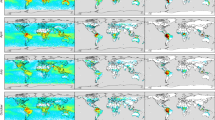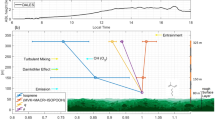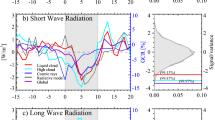Abstract
The most important chemical cleaning agent of the atmosphere is the hydroxyl radical1,2, OH. It determines the oxidizing power of the atmosphere, and thereby controls the removal of nearly all gaseous atmospheric pollutants3,4. The atmospheric supply of OH is limited, however, and could be overcome by consumption due to increasing pollution and climate change4,5,6, with detrimental feedback effects. To date, the high variability of OH concentrations has prevented the use of local observations to monitor possible trends in the concentration of this species. Here we present and analyse long-term measurements of atmospheric OH concentrations, which were taken between 1999 and 2003 at the Meteorological Observatory Hohenpeissenberg in southern Germany. We find that the concentration of OH can be described by a surprisingly linear dependence on solar ultraviolet radiation throughout the measurement period, despite the fact that OH concentrations are influenced by thousands of reactants. A detailed numerical model of atmospheric reactions and measured trace gas concentrations indicates that the observed correlation results from compensations between individual processes affecting OH, but that a full understanding of these interactions may not be possible on the basis of our current knowledge of atmospheric chemistry. As a consequence of the stable relationship between OH concentrations and ultraviolet radiation that we observe, we infer that there is no long-term trend in the level of OH in the Hohenpeissenberg data set.
This is a preview of subscription content, access via your institution
Access options
Subscribe to this journal
Receive 51 print issues and online access
$199.00 per year
only $3.90 per issue
Buy this article
- Purchase on Springer Link
- Instant access to full article PDF
Prices may be subject to local taxes which are calculated during checkout




Similar content being viewed by others
References
Levy, H. II Normal atmosphere: Large radical and formaldehyde concentrations predicted. Science 173, 141–143 (1971)
Ehhalt, D. H. Radical ideas. Science 279, 1002–1003 doi:10.1126/science.279.5353.1002 (1998)
Jacob, D. J. in Handbook of Weather, Climate and Water (eds Potter, T. D. & Colman, B. R.) 29–46 (Wiley & Sons, New York, 2003)
Lelieveld, J., Dentener, F. J., Peters, W. & Krol, M. C. On the role of hydroxyl radicals in the self-cleansing capacity of the troposphere. Atmos. Chem. Phys. 4, 2337–2344 (2004)
Prinn, R. G. et al. Evidence for substantial variations of atmospheric hydroxyl radicals in the past two decades. Science 292, 1882–1888 (2001)
Manning, M. R., Lowe, D. C., Moss, R. C., Bodeker, G. E. & Allan, W. Short-term variations in the oxidizing power of the atmosphere. Nature 436, 1001–1004 (2005)
Perner, D. et al. Measurements of tropospheric OH concentrations: A comparison of field data with model predictions. J. Atmos. Chem. 5, 185–216 (1987)
Platt, U., Rateike, M., Junkermann, W., Rudolph, J. & Ehhalt, D. H. New tropospheric OH measurements. J. Geophys. Res. 93, 5159–5166 (1988)
Dorn, H.-P., Callies, J., Platt, U. & Ehhalt, D. H. Measurement of tropospheric OH concentrations by laser long-path absorption spectroscopy. Tellus B 40, 437–445 (1988)
Eisele, F. L. & Tanner, D. J. Ion-assisted tropospheric OH measurements. J. Geophys. Res. 96, 9295–9308 (1991)
Wennberg, P. O. et al. In situ measurements of OH and HO2 in the upper troposphere and stratosphere. J. Atmos. Sci. 52, 3413–3420 (1995)
Crosley, D. R. The measurement of OH and HO2 in the atmosphere. J. Atmos. Sci. 52, 3299–3314 (1995)
Brune, W. H., Stevens, P. S. & Mather, J. H. Measuring OH and HO2 in the troposphere by laser-induced fluorescence at low pressure. J. Atmos. Sci. 52, 3328–3336 (1995)
Heard, D. E. & Pilling, M. J. Measurement of OH and HO2 in the troposphere. Chem. Rev. 103, 5163–5198 (2003)
World Meteorological Organisation Strategy for the Implementation of the Global Atmosphere Watch Programme (2001–2007) (GAW Rep. No. 142, WMO TD No 1077, WMO, Geneva, 2001)
Deutscher Wetterdienst, Global Atmosphere Watch. http://www.dwd.de/gaw (2002).
Holland, F., Aschmutat, U., Heßling, M., Hofzumahaus, A. & Ehhalt, D. H. Highly time resolved measurements of OH during POPCORN using laser-induced fluorescence spectroscopy. J. Atmos. Chem. 31, 205–225 (1998)
Brauers, Th., Hausmann, M., Bister, A., Kraus, A. & Dorn, H.-P. OH radicals in the boundary layer of the Atlantic Ocean 1. Measurements by long-path laser absorption spectroscopy. J. Geophys. Res. 106, 7399–7414 (2001)
Holland, F., Hofzumahaus, A., Schäfer, J., Kraus, A. & Pätz, H.-W. Measurements of OH and HO2 radical concentrations and photolysis frequencies during BERLIOZ. J. Geophys. Res. 108, 8246, doi:10.1029/2001JD001393 (2003)
Berresheim, H., Plass-Dülmer, C., Elste, T., Mihalopoulos, N. & Rohrer, F. OH in the coastal boundary layer of Crete during MINOS: Measurements and relationship with ozone photolysis. Atmos. Chem. Phys. 3, 639–649 (2003)
Ehhalt, D. H., Dorn, H.-P. & Poppe, D. The chemistry of the hydroxyl radical in the troposphere. Proc. R. Soc. Edinb. B 97, 17–34 (1991)
Ehhalt, D. H. & Rohrer, F. Dependence of the OH concentration on solar UV. J. Geophys. Res. 105, 3565–3571 (2000)
Faloona, I. et al. Nighttime observations of anomalously high levels of hydroxyl radicals above a deciduous forest canopy. J. Geophys. Res. 106 (D20), 24315–24333 (2001)
Hanisco, T. F. et al. Sources, sinks, and the distribution of OH in the lower stratosphere. J. Phys. Chem. 105, 1543–1553 (2001)
Berresheim, H., Elste, T., Plass-Dülmer, C., Eisele, F. L. & Tanner, D. J. Chemical ionization mass spectrometer for long-term measurements of atmospheric OH and H2SO4 . Int. J. Mass Spectrom. 202, 91–109 (2000)
Bohn, B., Kraus, A., Müller, M. & Hofzumahaus, A. Measurement of atmospheric O3 → O(1D) photolysis frequencies using filterradiometry. J. Geophys. Res. 109, D10S90, doi: 10.1029/2003JD004319 (2004)
Stockwell, W. R., Kirchner, F., Kuhn, M. & Seefeld, S. A new mechanism for regional atmospheric chemistry modelling. J. Geophys. Res. 102, 25847–25879 (1997)
Geiger, H., Barnes, I., Bejan, J., Benter, T. & Spittler, M. The tropospheric degradation of isoprene: an updated module for the regional atmospheric chemistry mechanism. Atmos. Environ. 37, 1503–1519 (2003)
Sillman, S., Logan, J. A. & Wofsy, S. The sensitivity of ozone to nitrogen oxides and hydrocarbons in regional ozone episodes. J. Geophys. Res. 95, 1837–1851 (1990)
Acknowledgements
We thank F. Eisele and D. Tanner for help in setting up the CIMS system at MOHp, T. Elste and G. Stange for OH measurements, and E. Tensing for J (O1D) measurements, D. H. Ehhalt, A. Wahner and C. Plass-Dülmer for discussions, the GAW team at MOHp for the ancillary data, and DWD/BMVBS for financial support.
Author information
Authors and Affiliations
Corresponding author
Ethics declarations
Competing interests
Reprints and permissions information is available at npg.nature.com/reprintsandpermissions. The authors declare no competing financial interests. Requests for the Hohenpeissenberg data sets should be addressed to H.B. (harald.berresheim@dwd.de).
Supplementary information
Supplementary Figures
This file contains Supplementary Figures 1–5. (PDF 153 kb)
Supplementary Tables
This file contains Supplementary Figures 1–6. (PDF 164 kb)
Rights and permissions
About this article
Cite this article
Rohrer, F., Berresheim, H. Strong correlation between levels of tropospheric hydroxyl radicals and solar ultraviolet radiation. Nature 442, 184–187 (2006). https://doi.org/10.1038/nature04924
Received:
Accepted:
Issue Date:
DOI: https://doi.org/10.1038/nature04924
This article is cited by
-
Inferring the diurnal variability of OH radical concentrations over the Amazon from BVOC measurements
Scientific Reports (2023)
-
VOC species controlling O3 formation in ambient air and their sources in Kaifeng, China
Environmental Science and Pollution Research (2023)
-
Sulfate formation is dominated by manganese-catalyzed oxidation of SO2 on aerosol surfaces during haze events
Nature Communications (2021)
-
Physicochemical properties of polysaccharides from Dendrobium officinale by fractional precipitation and their preliminary antioxidant and anti-HepG2 cells activities in vitro
Chemistry Central Journal (2018)
-
Lightning Discharges, Cosmic Rays and Climate
Surveys in Geophysics (2018)
Comments
By submitting a comment you agree to abide by our Terms and Community Guidelines. If you find something abusive or that does not comply with our terms or guidelines please flag it as inappropriate.



